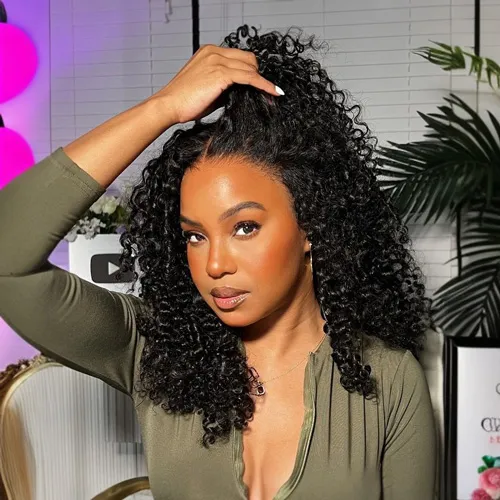What Does Density Mean In Wigs: How To Choose
What does density mean in wigs, and how do you choose the right one for you? In this article, we will delve into the intricacies of wig density, exploring its significance, variations, and providing expert tips on selecting the perfect wig density for your desired look.

I. What is wig density?
Wig density refers to the amount of hair on a wig cap and is a crucial factor in determining the overall appearance and realism of the wig. Simply put, it measures how thick or thin the hair on the wig is. The density is typically expressed as a percentage, with higher percentages indicating thicker and fuller hair.
Understanding wig density is essential for achieving a natural and flattering look. Different densities cater to various preferences and style choices, ensuring that individuals can find a wig that suits their unique needs.

II. Wig density chart: Understanding the percentages.
To make an informed decision when choosing a wig, it’s essential to familiarize yourself with the density percentages and their corresponding characteristics. Here is a general guide to help you understand the variations in wig density:
Light density (80-100%):
Ideal for a natural and subtle look.
Mimics the density of natural hair.
Suitable for individuals with fine or thin hair.
Medium density (120-130%):
Offers a balance between natural and voluminous.
Provides a fuller appearance without being overly thick.
Suitable for most individuals seeking a versatile option.
Heavy density (150% and above):
Creates a dramatic and voluminous look.
Ideal for those who prefer a bold, statement hairstyle.
Not recommended for individuals who want a natural or understated appearance.

III. Does wig density matter?
Yes, wig density does matter, and it plays a significant role in the overall appearance and realism of a wig. Here are several reasons why wig density is an important consideration:
1. Natural look:
The density of a wig directly impacts how natural it looks on the wearer. Choosing the right density ensures that the wig closely resembles the density of natural hair, creating a seamless and authentic appearance.
2. Comfort:
The density of a wig can affect its weight and comfort. Lighter density wigs are generally more lightweight and comfortable for extended wear, while heavy density wigs may feel denser and warmer. Considering personal comfort is crucial, especially for individuals who plan to wear the wig for long periods.
3. Face shape enhancement:
The right wig density can complement and enhance different face shapes. For example, individuals with a round face might opt for a medium density to add some volume, while those with a more angular face may choose a lighter density for a softer look.
4. Occasion-specific styles:
The density of a wig can be chosen based on the occasion or purpose. Lighter densities are often preferred for everyday wear, providing a more natural and understated look. On the other hand, heavier densities may be chosen for special events or performances where a bold and glamorous style is desired.
5. Styling options:
The density of a wig can influence its styling options. Lighter densities may be easier to style and manipulate, while heavier densities can provide a fuller base for more elaborate hairstyles. Individuals who enjoy experimenting with different looks may choose a wig density that aligns with their styling preferences.
6. Hair type compatibility:
Consideration of natural hair type is important when selecting wig density. Individuals with fine or thin hair may find lighter densities more suitable, as they mimic the natural thickness of their own hair. Those with thicker natural hair may opt for medium to heavy densities for a realistic appearance.
VI. How to choose a suitable wig density?
Selecting the right wig density is a crucial aspect of achieving a natural and personalized look. Here’s a step-by-step guide to help you choose a suitable wig density:
1. Determine your style preference:
Consider the style you want to achieve. If you prefer a subtle, natural look, opt for a lighter density (80-100%). For those desiring more volume and thickness, medium density (120-130%) is a balanced choice, while heavy density (150% and above) creates a bold, dramatic effect.
2. Take your face shape into account:
Your face shape can influence the choice of wig density. For example, if you have a round face, a medium density wig can add volume and balance. Oval faces offer more flexibility with different densities, while those with angular faces may prefer a lighter density for a softer look.
3. Evaluate your natural hair type:
Consider the thickness and texture of your natural hair. If you have thin or fine hair, a lighter density wig is likely to provide a more seamless match. Individuals with thicker hair may find that medium to heavy densities offer a more realistic appearance.
4. Think about the occasion:
The occasion for which you intend to wear the wig matters. Lighter densities are suitable for everyday wear, offering a natural and understated look. For special events or performances, you might opt for a heavier density to make a bold statement.
5. Experiment and consult:
Try on different wigs with various densities to see how they suit your style. Many wig retailers offer the opportunity to experiment with different options. Additionally, consult with wig specialists who can provide personalized recommendations based on your preferences and needs.
6. Prioritize quality:
Invest in a high-quality wig. Quality not only affects the appearance but also the longevity of the wig. A well-crafted wig with the right density will look more natural and require less maintenance over time.
7. Consider comfort:
Think about how long you plan to wear the wig. Lighter densities are generally more comfortable for extended wear, particularly in warmer conditions. If you’re wearing the wig for special occasions, a heavier density may be more appropriate.
8. Factor in maintenance:
Different densities may require varying levels of maintenance. Lighter densities often demand less care, while heavier densities may need more attention to retain their shape and style. Choose a density that aligns with your willingness to invest time in maintenance.
9. Seek customer feedback:
Read customer reviews and feedback for specific wig densities and styles. Real-world experiences can provide valuable insights into how a particular density performs in various situations.
10. Trust your instincts:
Ultimately, trust your instincts and choose a density that makes you feel confident and comfortable. Your personal preference and style should guide your decision, ensuring that the wig not only looks great but also enhances your overall confidence.
FAQs about wig density.
1. How do I know which wig density is right for me?
Choosing the right wig density depends on your personal style, face shape, natural hair type, and the occasion. Light density (80-100%) offers a natural look, medium density (120-130%) provides balance, and heavy density (150% and above) creates a bold, dramatic effect.
2. Can I choose a wig density based on my face shape?
Yes, your face shape can guide your choice of wig density. For instance, individuals with a round face may opt for medium density to add volume, while those with an oval face can experiment with different densities based on their preferences.
3. Is there a specific wig density for certain occasions?
Lighter densities are often suitable for everyday wear, providing a natural appearance. Heavier densities may be chosen for special events or performances where a more glamorous and striking look is desired.
4. How does wig density relate to comfort?
Lighter densities are generally more comfortable for extended wear, especially in warmer conditions. If comfort is a priority, consider a density that aligns with your preferences and the duration for which you plan to wear the wig.
5. Can I experiment with different wig densities before making a final decision?
Yes, many wig retailers offer a variety of density options, allowing you to try different wigs and find the one that suits you best. Experimentation and trying on different densities are encouraged to make an informed decision.
6. Does wig density affect maintenance requirements?
Yes, higher-density wigs may require more maintenance to keep them looking their best. Lighter densities are generally easier to care for, making them a suitable choice for those who prefer low-maintenance options.
7. How can I ensure the longevity of a wig with the right density?
Invest in a high-quality wig with the appropriate density. Quality craftsmanship ensures a more realistic appearance and longer-lasting wear. Follow proper care and maintenance practices to preserve the wig’s longevity.
8. Are there myths about wig density that I should be aware of?
Yes, some myths include the misconception that more density is always better or that light density looks unnatural. Understanding the reality behind these myths can help you make more informed decisions when choosing a wig.
In a nutshell.
Understanding density is a crucial aspect of achieving a natural and flattering look. By considering factors such as personal style, face shape, and occasion, individuals can confidently choose the right wig density for them. Remember, experimentation is key, and consulting with experts can provide valuable insights into finding the perfect wig that enhances your beauty and boosts your confidence. Whether you opt for a light, medium, or heavy density, the world of wigs is diverse and ready to cater to your unique style preferences.
